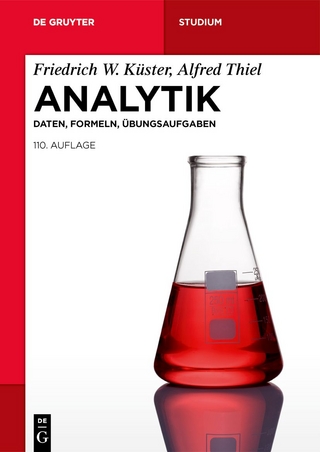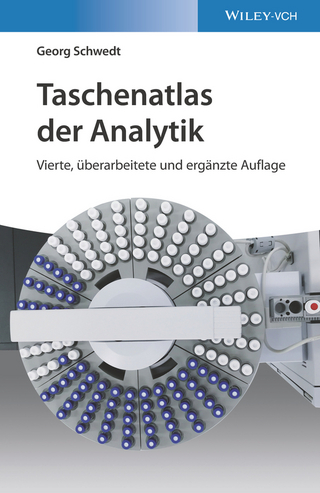
Guide to Fluorine NMR for Organic Chemists
John Wiley & Sons Inc (Verlag)
978-1-118-83108-3 (ISBN)
Following its well-received predecessor, this book offers an essential guide to chemists for understanding fluorine in spectroscopy. With over 1000 compounds and 100 spectra, the second edition adds new data – featuring fluorine effects on nitrogen NMR, chemical shifts, and coupling constants.
• Explains how to successfully incorporate fluorine into target molecules and utilize fluorine substituents to structurally characterize organic compounds
• Includes new data on nitrogen NMR, focusing on N-15, to portray the influence of fluorine upon nitrogen NMR chemical shifts and coupling constants
• Expands on each chapter from the first edition with additional data and updated discussion from recent findings
• "The flawless ordering of material covered in this stand-alone volume is such that information can be found very easily." – Angewandte Chemie review of the first edition, 2010
William R. Dolbier, Jr., is the Col. Allen R. and Margaret G. Crow Professor of Chemistry at the University of Florida. He received his BS in chemistry from Stetson University in 1961 and his PhD in organic chemistry from Cornell University in 1965. Following a postdoctoral appointment at Yale University, he joined the faculty at the University of Florida in 1966. Professor Dolbier was the recipient of the 2000 American Chemical Society (ACS) Award for Creative Work in Fluorine Chemistry, and is a past member of the Executive Committee of the Fluorine Division of the ACS.
PREFACE xv
1 GENERAL INTRODUCTION 1
1.1. Why Fluorinated Compounds are Interesting? / 1
1.1.1. Steric Size / 1
1.1.2. Polar Effects / 2
1.1.3. Effect of Fluorine Substituents on Acidity and Basicity of Compounds / 2
1.1.4. Effect of Fluorinated Substituents on Lipophilicity of Molecules / 3
1.1.5. Other Effects / 4
1.1.6. Analytical Applications in Biomedicinal Chemistry / 4
1.2. Introduction to Fluorine NMR / 5
1.2.1. Chemical Shifts / 5
1.2.2. Coupling Constants / 7
2 AN OVERVIEW OF FLUORINE NMR 9
2.1. Introduction / 9
2.2. Fluorine Chemical Shifts / 10
2.2.1. Some Aspects of Shielding/Deshielding Effects on Fluorine Chemical Shifts / 11
2.2.2. Solvent Effects on Fluorine Chemical Shifts / 15
2.2.3. Overall Summary of Fluorine Chemical Shift Ranges / 16
2.3. The Effect of Fluorine Substituents on Proton Chemical Shifts / 17
2.4. The Effect of Fluorine Substituents on Carbon Chemical Shifts / 18
2.5. The Effect of Fluorine Substituents on 31P Chemical Shifts / 19
2.6. The Effect of Fluorine Substituents on 15N Chemical Shifts / 20
2.7. Spin–Spin Coupling Constants to Fluorine / 23
2.7.1. Effect of Molecule Chirality on Coupling / 27
2.7.2. Through-Space Coupling / 29
2.7.3. Fluorine–Fluorine Coupling / 32
2.7.4. Coupling Between Fluorine and Hydrogen / 33
2.7.5. Coupling Between Fluorine and Carbon / 35
2.7.6. Coupling Between Fluorine and Phosphorous / 38
2.7.7. Coupling Between Fluorine and Nitrogen / 39
2.8. Second-Order Spectra / 40
2.9. Isotope Effects on Chemical Shifts / 45
2.10. Advanced Topics / 48
2.10.1. Multidimensional 19F NMR / 50
3 THE SINGLE FLUORINE SUBSTITUENT 55
3.1. Introduction / 55
3.1.1. Chemical Shifts – General Considerations / 56
3.1.2. Spin–Spin Coupling Constants – General Considerations / 56
3.2. Saturated Hydrocarbons / 57
3.2.1. Primary Alkyl Fluorides / 57
3.2.2. Secondary Alkyl Fluorides / 61
3.2.3. Tertiary Alkyl Fluorides / 63
3.2.4. Cyclic and Bicyclic Alkyl Fluorides / 66
3.3. Influence of Substituents/Functional Groups / 70
3.3.1. Halogen Substitution / 70
3.3.2. Alcohol, Ether, Epoxide, Ester, Sulfide, Sulfone, Sulfonate, and Sulfonic Acid Groups / 77
3.3.3. Amino, Ammonium, Azide, and Nitro Groups / 80
3.3.4. Phosphorous Compounds / 83
3.3.5. Silanes, Stannanes, and Germanes / 83
3.4. Carbonyl Functional Groups / 84
3.4.1. Aldehydes and Ketones / 85
3.4.2. Carboxylic Acid Derivatives / 86
3.4.3. 1H and 13C NMR Data for Aldehydes, Ketones, and Esters / 86
3.4.4. β-Ketoesters, Diesters, and Nitroesters / 89
3.5. Nitriles / 89
3.5.1. 1H and 13C NMR Data for Nitriles / 89
3.6. Alkenes with a Single Fluorine Substituent / 90
3.6.1. Hydrocarbon Alkenes / 90
3.6.2. Conjugated Alkenyl Systems / 93
3.6.3. Allylic Alcohols, Ethers, and Halides / 94
3.6.4. Halofluoroalkenes and Fluorovinyl Ethers / 97
3.6.5. Geminal Fluoro, Hetero Alkenes / 98
3.6.6. Multifluoroalkenes / 98
3.6.7. α,β-Unsaturated Carbonyl Compounds / 101
3.7. Acetylenic Fluorine / 104
3.8. Allylic and Propargylic Fluorides / 105
3.8.1. 1H and 13C NMR Data / 106
3.9. Fluoroaromatics / 106
3.9.1. Monofluoroaromatics / 106
3.9.2. Fluoropolycyclic Aromatics: Fluoronaphthalenes / 111
3.9.3. Polyfluoroaromatics / 112
3.10. Fluoromethyl Aromatics / 114
3.11. Fluoroheterocycles / 119
3.11.1. Fluoropyridines, Quinolines, and Isoquinolines / 119
3.11.2. Fluoropyrimidines and Other Fluorine-Substituted Six-Membered Ring Heterocycles / 122
3.11.3. Fluoromethyl Pyridines and Quinolines / 123
3.11.4. Fluoropyrroles and Indoles / 123
3.11.5. Fluoromethyl Pyrroles and Indoles / 125
3.11.6. Fluorofurans and Benzofurans / 125
3.11.7. Fluoromethyl Furans and Benzofurans / 126
3.11.8. Fluorothiophene and Benzothiophene / 127
3.11.9. Fluoromethyl Thiophenes and Benzothiophenes / 128
3.11.10. Fluoroimidazoles and Pyrazoles / 128
3.11.11. Fluoromethyl and Fluoroalkyl Imidazoles, 1H-pyrazoles, Benzimidazoles, 1H-triazoles, Benzotriazoles, and Sydnones / 128
3.12. Other Common Groups with a Single Fluorine Substituent / 129
3.12.1. Acyl Fluorides / 130
3.12.2. Fluoroformates / 131
3.12.3. Sulfinyl and Sulfonyl Fluorides / 131
4 THE CF2 GROUP 133
4.1. Introduction / 133
4.1.1. Chemical Shifts – General Considerations / 134
4.1.2. Spin–Spin coupling Constants – General Considerations / 135
4.2. Saturated Hydrocarbons Containing a CF2 Group / 135
4.2.1. Alkanes Bearing a Primary CF2H Group / 136
4.2.2. Secondary CF2 Groups / 139
4.2.3. Discussion of Coupling Constants Within CF2 Groups / 142
4.2.4. Pertinent 1H Chemical Shift Data / 143
4.2.5. Pertinent 13C NMR Data / 146
4.3. Influence of Substituents/Functional Groups / 148
4.3.1. Halogen Substitution / 148
4.3.2. Alcohol, Ether, Esters, Thioether, and Related Substituents / 152
4.3.3. Epoxides / 155
4.3.4. Sulfoxides, Sulfones, Sulfoximines, and Sulfonic Acids / 156
4.3.5. Multifunctional β,β-Difluoro Alcohols / 157
4.3.6. Compounds with Two Different Heteroatom Groups Attached to CF2 Including Chloro- and Bromodifluoromethyl Ethers / 157
4.3.7. Amines, Azides, and Nitro Compounds / 158
4.3.8. Phosphines, Phosphonates, and Phosphonium Compounds / 162
4.3.9. Silanes, Stannanes, and Germanes / 162
4.3.10. Organometallics / 162
4.4. Carbonyl Functional Groups / 164
4.4.1. Aldehydes and Ketones / 164
4.4.2. Carboxylic Acids and Derivatives / 166
4.5. Nitriles / 168
4.5.1. 1H and 13C NMR Spectra of Nitriles / 168
4.6. Amino-, Hydroxyl-, and Keto-Difluorocarboxylic Acid Derivatives / 169
4.7. Sulfonic Acid Derivatives / 170
4.8. Alkenes and Alkynes / 170
4.8.1. Simple Alkenes with Terminal Vinylic CF2 Groups / 170
4.8.2. Conjugated Alkenes with Terminal Vinylic CF2 Group / 172
4.8.3. Cumulated Alkenes with a Terminal CF2 Group / 174
4.8.4. Effect of Vicinal Halogen or Ether Function / 174
4.8.5. Effect of Allylic Substituents / 174
4.8.6. Polyfluoroethylenes / 175
4.8.7. Trifluorovinyl Group / 175
4.8.8. α,β-Unsaturated Carbonyl Systems with a Terminal Vinylic CF2 Group / 176
4.8.9. Allylic and Propargylic CF2 Groups / 177
4.9. Benzenoid Aromatics Bearing a CF2H or CF2R Group / 178
4.9.1. 1H and 13C NMR Data / 179
4.9.2. CF2 Groups with More Distant Aryl Substitutents / 180
4.10. Heteroaromatic CF2 Groups / 180
4.10.1. Pyridines, Quinolones, Phenanthridines, and Acridines / 181
4.10.2. Furans, Benzofurans, Thiophenes, Pyrroles, and Indoles / 181
4.10.3. Pyrimidines / 183
4.10.4. Five-Membered Ring Heterocycles with Two Hetero Atoms: Imidazoles, Benzimidazoles, 1H-pyrazoles, Oxazoles, Isoxazoles, Thiazoles, and Indazoles / 183
4.10.5. Five-Membered Ring Heterocycles with Three or More Heteroatoms: Sydnones, Triazoles, and Benzotriazoles / 183
4.10.6. Various Other Difluoromethyl-Substituted Heterocyclic Systems / 185
5 THE TRIFLUOROMETHYL GROUP 187
5.1. Introduction / 187
5.1.1. NMR Spectra of Compounds Containing the CF3 Group – General Considerations / 187
5.2. Saturated Hydrocarbons Bearing a CF3 Group / 189
5.2.1. Alkanes Bearing a CF3 Group / 189
5.2.2. Cycloalkanes Bearing a CF3 Group / 189
5.2.3. 1H and 13C NMR Data, General Information / 191
5.3. Influence of Substituents and Functional Groups / 193
5.3.1. Impact of Halogens / 193
5.3.2. Ethers, Alcohols, Esters, Sulfides, and Selenides / 195
5.3.3. Sulfones, Sulfoxides, and Sulfoximines / 200
5.3.4. Amines and Nitro Compounds / 200
5.3.5. Trifluoromethyl Imines, Oximes, Hydrazones, Imidoyl Chlorides, Nitrones, Diazo and Diazirine Compounds / 204
5.3.6. Phosphines and Phosphonium Compounds / 205
5.3.7. Organometallics / 205
5.4. Boronic Esters / 207
5.5. Carbonyl Compounds / 207
5.5.1. 1H and 13C NMR Data / 209
5.6. Nitriles / 213
5.6.1. 13C NMR Data for Nitriles / 213
5.7. Bifunctional Compounds / 214
5.8. Sulfonic Acid Derivatives / 214
5.9. Allylic and Propargylic Trifluoromethyl Groups / 214
5.9.1. Allylic Trifluoromethyl Groups / 215
5.9.2. α,β-Unsaturated Carbonyl Compounds / 219
5.9.3. More Heavily Fluorinated Allylics / 222
5.9.4. Propargylic Trifluoromethyl Groups / 222
5.10. Aryl-Bound Trifluoromethyl Groups / 223
5.10.1. Proton and Carbon NMR Data / 224
5.10.2. Multitrifluoromethylated Benzenes / 225
5.11. Heteroaryl-Bound Trifluoromethyl Groups / 228
5.11.1. Pyridines, Quinolines, and Isoquinolines / 228
5.11.2. Pyrimidines and Quinoxalines / 229
5.11.3. Pyrroles and Indoles / 229
5.11.4. Thiophenes and Benzothiophenes / 230
5.11.5. Furans / 230
5.11.6. Imidazoles and Benzimidazoles / 232
5.11.7. Oxazoles, Isoxazoles, Oxazolidines, Thiazoles, 1H-pyrazoles, 1H-indazoles, Benzoxazoles, and Benzothiazoles / 234
5.11.8. Triazoles and Tetrazoles / 235
6 MORE HIGHLY FLUORINATED GROUPS 237
6.1. Introduction / 237
6.2. The 1,1,2- and 1,2,2-Trifluoroethyl Groups / 238
6.3. The 1,1,2,2-Tetrafluoroethyl and
2,2,3,3-Tetrafluoropropyl Groups / 241
6.4. The 1,2,2,2-Tetrafluoroethyl Group / 242
6.5. The Pentafluoroethyl Group / 245
6.5.1. Pentafluoroethyl Carbinols / 248
6.5.2. Pentafluoroethyl Ethers, Sulfides, and Phosphines / 248
6.5.3. Pentafluoroethyl Organometallics / 249
6.6. The 2,2,3,3,3-Pentafluoropropyl Group / 249
6.7. The 1,1,2,3,3,3-Hexafluoropropyl Group / 251
6.8. 1,1,2,2,3,3-Hexafluoropropyl System / 252
6.9. The Hexafluoro-Isopropyl Group / 254
6.10. The Heptafluoro-n-Propyl Group / 255
6.11. The Heptafluoro-iso-Propyl Group / 255
6.12. The Nonafluoro-n-Butyl Group / 255
6.13. The Nonafluoro-iso-Butyl Group / 258
6.14. The Nonafluoro-t-Butyl Group / 258
6.15. Fluorous Groups / 258
6.16. 1-Hydro-Perfluoroalkanes / 259
6.17. Perfluoroalkanes / 260
6.18. Perfluoro-n-Alkyl Halides / 263
6.19. Perfluoroalkyl Amines, Ethers, and Carboxylic Acid Derivatives / 263
6.20. Polyfluoroalkenes / 264
6.20.1. Trifluorovinyl Groups / 264
6.20.2. Perfluoroalkenes / 267
6.21. Polyfluorinated Aromatics / 268
6.21.1. 2,3,5,6-Tetrafluorobenzene Compounds / 268
6.21.2. The Pentafluorophenyl Group / 268
6.22. Polyfluoroheterocyclics / 269
6.22.1. Polyfluoropyridines / 269
6.22.2. Polyfluorofurans / 269
6.22.3. Polyfluorothiophenes / 269
6.22.4. Polyfluoropyrimidines / 271
7 COMPOUNDS AND SUBSTITUENTS WITH FLUORINE DIRECTLY BOUND TO A HETEROATOM 273
7.1. Introduction / 273
7.2. Boron Fluorides / 275
7.3. Fluorosilanes / 275
7.4. Nitrogen Fluorides / 275
7.4.1. Electrophilic Fluorinating Agents / 276
7.5. Phosphorous Fluorides / 277
7.5.1. Phosphorous (III) Fluorides / 277
7.5.2. Phosphorous (V) Fluorides / 277
7.5.3. Phosphorous (V) Oxyfluorides / 280
7.5.4. Cyclophosphazenes / 280
7.6. Oxygen Fluorides (Hypofluorites) / 281
7.7. Sulfur Fluorides / 282
7.7.1. Inorganic Sulfur, Selenium, and Tellurium Fluorides / 282
7.7.2. Diarylsulfur, Selenium, and Tellurium Difluorides / 282
7.7.3. Aryl and Alkyl SF3 Compounds / 283
7.7.4. Dialkylaminosulfur Trifluorides / 283
7.7.5. Hypervalent Sulfur Fluorides / 284
7.7.6. Related Hypervalent Selenium and Tellurium Fluorides / 287
7.7.7. Organic Sulfinyl and Sulfonyl Fluorides / 288
7.8. The Pentafluorosulfanyl (SF5) Group in Organic Chemistry / 289
7.8.1. Saturated Aliphatic Systems / 292
7.8.2. Vinylic SF5 Substituents / 294
7.8.3. Acetylenic SF5 Substituents / 296
7.8.4. Aromatic SF5 Substituents / 297
7.8.5. Heterocyclic SF5 Compounds / 302
7.9. Bromine Trifluoride, Iodine Trifluoride, and Iodine Pentafluoride / 304
7.10. Aryl and Alkyl Halogen Difluorides and Tetrafluorides / 304
7.11. Xenon Fluorides / 305
INDEX 307
| Erscheinungsdatum | 08.04.2016 |
|---|---|
| Verlagsort | New York |
| Sprache | englisch |
| Maße | 163 x 236 mm |
| Gewicht | 726 g |
| Themenwelt | Naturwissenschaften ► Chemie ► Analytische Chemie |
| Naturwissenschaften ► Chemie ► Organische Chemie | |
| ISBN-10 | 1-118-83108-X / 111883108X |
| ISBN-13 | 978-1-118-83108-3 / 9781118831083 |
| Zustand | Neuware |
| Informationen gemäß Produktsicherheitsverordnung (GPSR) | |
| Haben Sie eine Frage zum Produkt? |
aus dem Bereich


